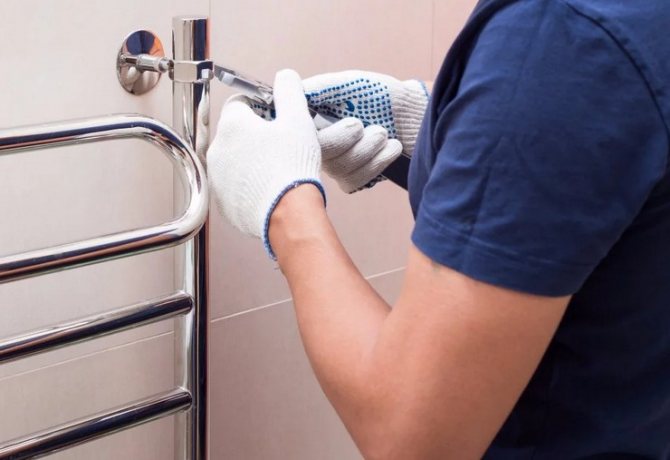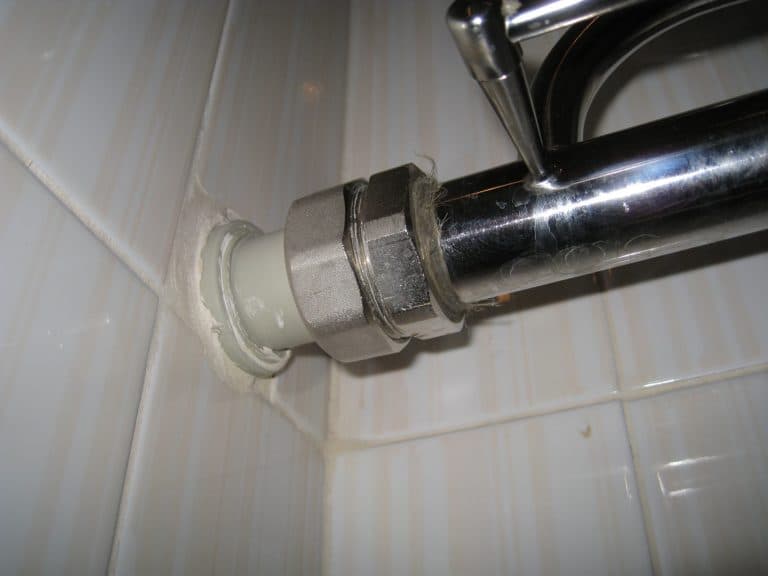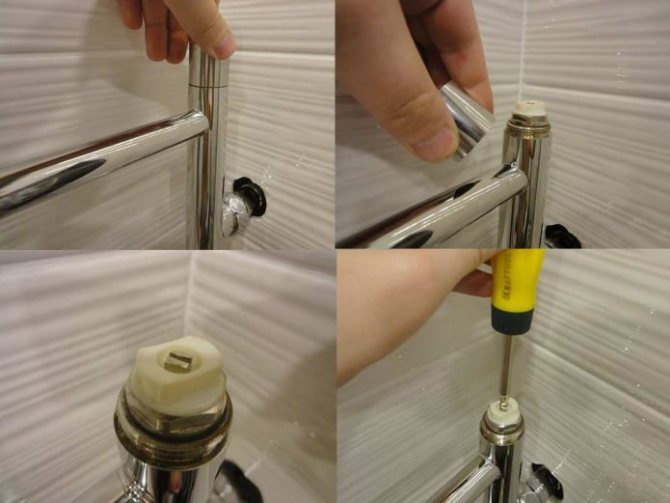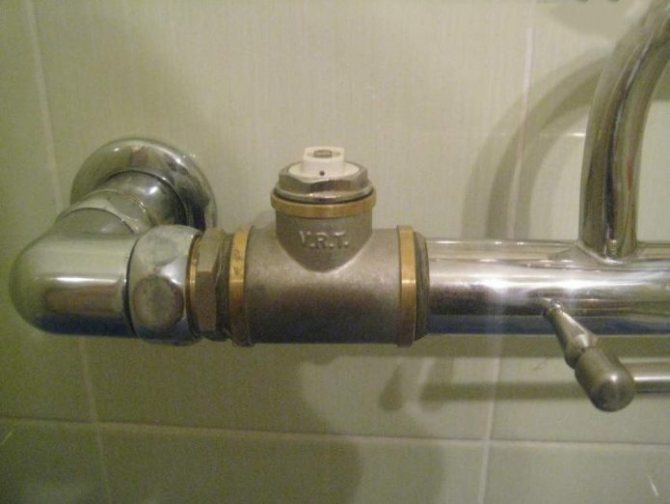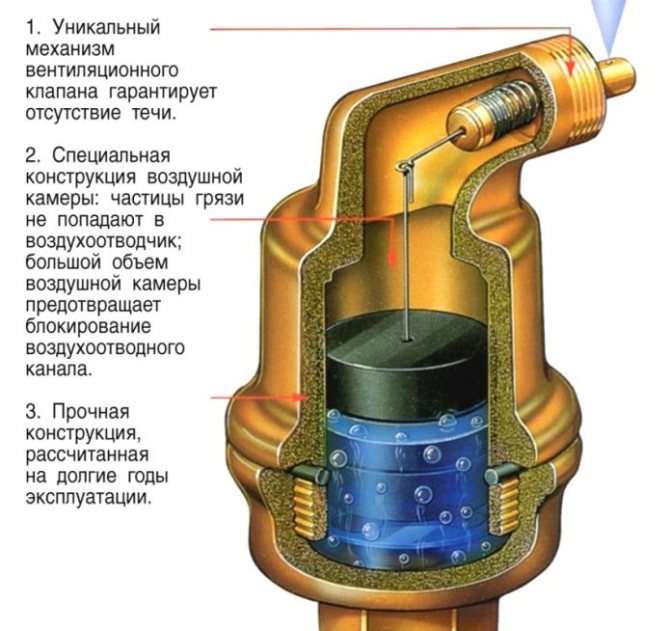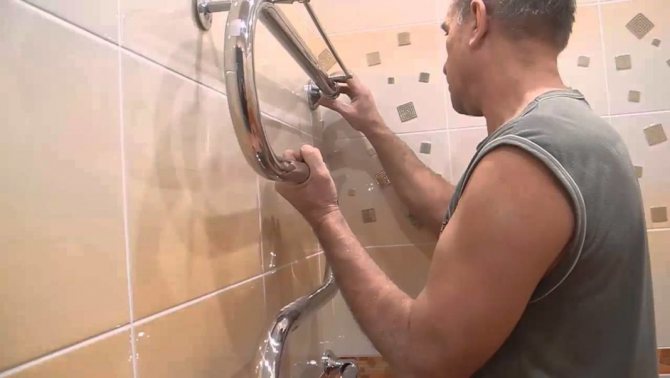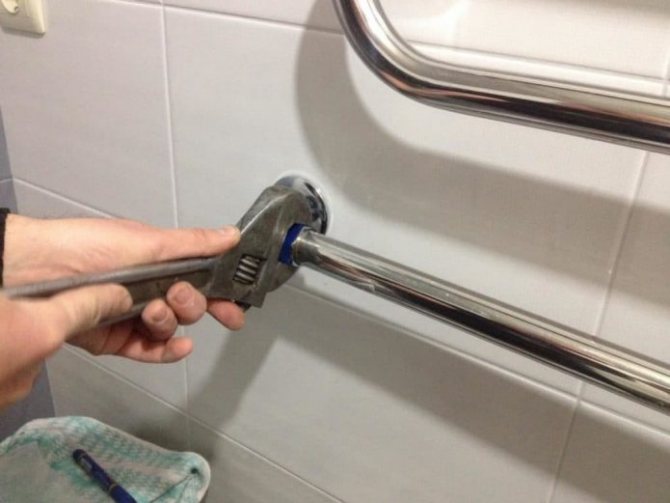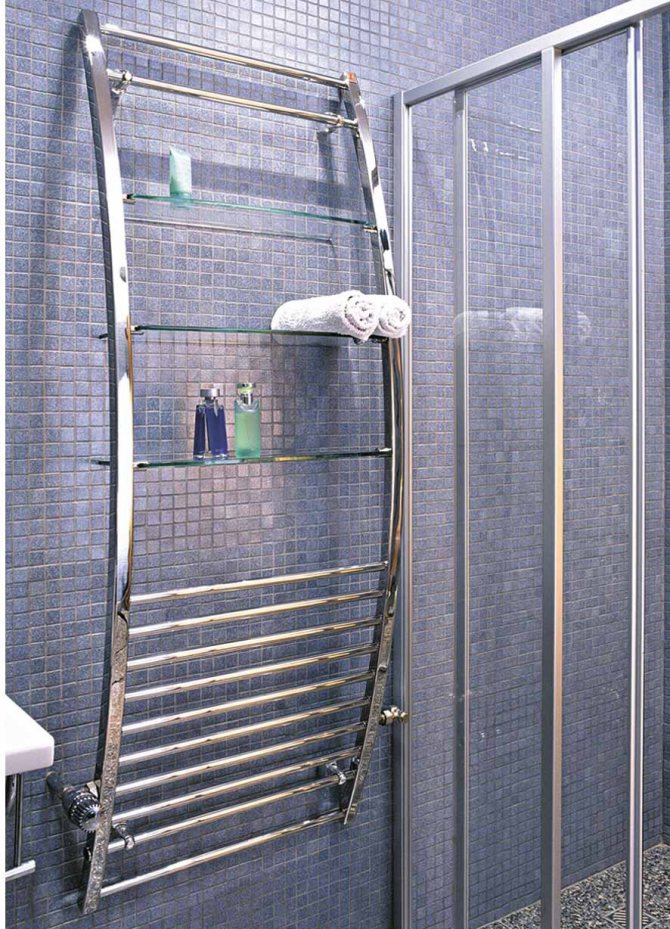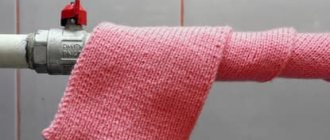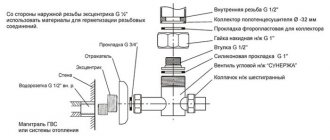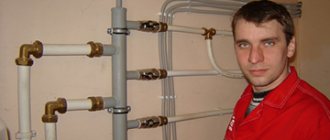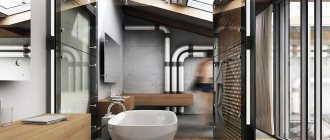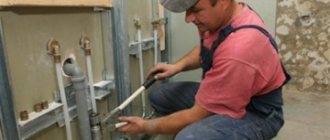Why you need to bleed the air from the heated towel rail
The heated towel rail is designed to dry wet laundry. Thanks to this device, the microclimate in the room is maintained. Drying helps to soften the environment. As a result, a large number of harmful microorganisms are prevented from appearing on walls, baseboards and ceilings:
- mold;
- fungus.
After long-term use of the product, the water circulation may be disturbed. Air mass begins to accumulate inside the unit. A blockage occurs, which affects the functionality of the device. It stops heating up, there is a loss of its properties and positive qualities. To get rid of the plug, you need to drain the water. The main reasons for performing such an operation are considered:
- The evaporation of hot water in the pipes is very slow. This phenomenon is associated with the formation of air bubbles inside the pipe, which interfere with the free movement of the heated liquid.
- Another reason may be the restart of the water supply, if for some reason there was a break in operation.
- The cork appears due to the incorrectly selected shape of the product.
- Incorrect connection.
In order not to deteriorate the quality of the atmosphere, the airlock must be eliminated.
How often to bleed air from the heated towel rail
Many users face this problem. Let's say right away, as soon as there is a problem with the supply of heat, the operation must be performed immediately. There is no need to postpone bleeding air from the heated towel rail until later, as this process begins to aggravate significantly over time. If everything is done on time, after the mass is released, the design of the device will begin to work at full power.
Installation of the Mayevsky crane
Do not be afraid that the Mayevsky crane is a difficult system that is difficult to install and expensive. Absolutely not, the crane is only two parts: the body and the tapered screw.
Mayevsky crane with a key
The purpose of the tap is to take air out to the outside, guaranteeing the good work of the towel dryer.
The principle of operation of the device: when the tap is open, air from the structure enters the body, where it is removed through the side opening; when the screw is closed, neither air nor liquid is able to escape from the pipeline.
When choosing a Mayevsky tap, look at the diameter of the external thread, it must correspond to the size of your pipes that are used in the heating system.
It all depends on the system, the Mayevsky crane can be opened and closed either by hand, or with a specialized key, a screwdriver.
When installing the tap, make sure that the hole is at the bottom of the tap. In this version, collecting water, it will immediately fall into the container, and not on the walls of the bath. And the tap itself must be installed on top of the towel dryer, so that it is easier to release the air.
Reviews of many buyers are advised to use the services of a master when installing a Mayevsky crane. It is very easy to remove the air, but the master is obliged to carry out the installation.
Air in a heated towel rail is not a difficulty, it is rather a single incident in a couple of years. The issue can be resolved without problems and easily, for which no more than one day will be useful.
Follow our advice, act carefully and take your time, then you will very easily cope with the task, and your towels will again become dry and warm.
You have read the post - Air in a heated towel rail: how to remove air jams?
How to release air from a heated towel rail: instructions
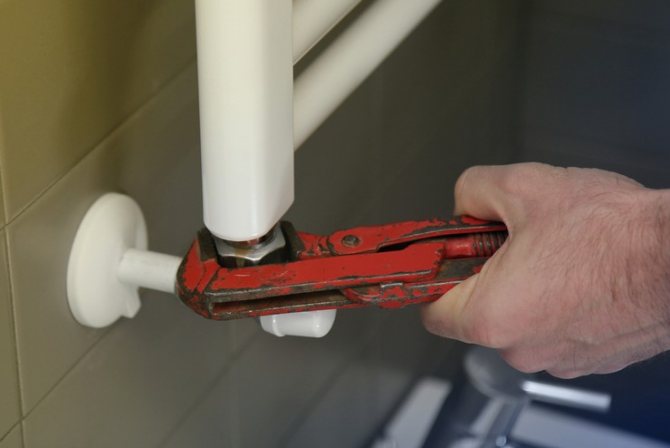
To return the lost power to the device, you must first study the principle of its operation, familiarize yourself with some of the features and nuances. The flushing operation does not require professional assistance. Any user can independently perform it. There are several ways to eliminate an airlock.
The classic way
This standard method is used to remove airlock by draining water from a heated towel rail. However, in order to do this, consideration must be given to the location of the dryer. If this is a multi-storey building, you need to familiarize yourself with the water cut-off scheme so that you can open the tap. If the water can be drained directly in the apartment, the need to shut off the entire system disappears, it becomes possible to drain the liquid on its own. The whole operation is carried out in several stages:
- First, unscrew the nut that connects the dryer and the DHW pipe. To do this, you need an adjustable wrench.
- To drain, you need to prepare a large container for draining the water in advance.
- Then, after the weakening of the product occurs, it is necessary to wait for the characteristic hiss.
- The final operation will be the release of the fluid.
Reference! After the air outlet from the heated towel rail stops, the nut can be tightened again.
If the above technique does not give a positive result, you can use other methods:
- Sometimes in old houses, solving a problem is associated with an individual approach to the situation that has arisen. We'll have to contact the tenant on the top floor. Bleeding air is done precisely from his apartment. The explanation is very simple. The DHW riser is laid in such a way that its route starts from the lower floor, gradually going up. Reaching the ultimate point, the riser makes a loop and rushes down. This installation causes air to accumulate at the top. That is, it is necessary to carry out the same actions, only from a completely different room.
- The design of modern nine-story buildings provides for the installation of a hot water outlet and water pipes in the attic. Therefore, in the attic you need to open the tap, drain all the water into the sewer. The negative side of this installation is its inaccessibility. Only plumbers are allowed to enter the attic area. It is impossible to drain the water without them.
- If your building has a different layout, you need to contact a special service for help. They will quickly find the necessary plumbing and help to eliminate the malfunction that has arisen.
Method using a Mayevsky crane
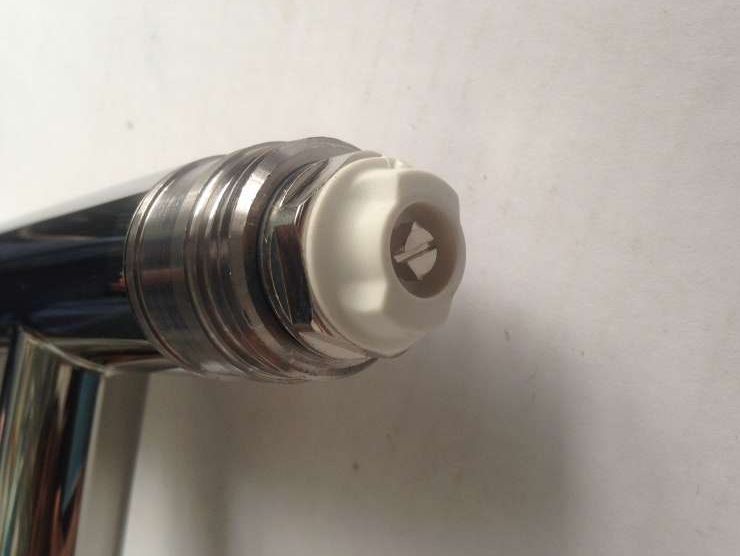

This method is considered to be the most perfect. It is executed in a specific sequence:
- First, prepare a large container into which the water will be drained. It is installed on a flat surface directly under the tap.
- Loosen the screw a little.
- When the hissing stops, water should start pouring out of the pipe. You need to wait for the moment when the water will flow out without air. Consequently, the bleeding was successful.
- The screw is tightened back.
From all of the above, an unambiguous conclusion can be drawn. The problem of bleeding air from a heated towel rail is solved very simply. You can perform such an operation without professional help in various ways.
Household Appliances Towel Warmer
Typical problem
After some time of active use, you may be unpleasantly surprised to find that it has stopped heating, and sometimes even completely cold. Air trapped inside the heated towel rail disrupts the correct circulation of watertherefore the tumble dryer does not heat up. There remains only one correct decision - to lower it.
If it is cold for a long time, it can negatively affect the air quality in the bathroom, and mold will begin to appear on the walls and ceiling.
Why is there an air lock in the heating system? If we consider central heating, then this due to the ingress of air into the system at the time of its launch... Another common problem is the slow evaporation of hot water in the pipes. Bubbles fill the place of the former water, which makes it difficult to supply hot water.
Next, we will consider how to pump a heated towel rail and eliminate airflow.
Installation of a jumper to be able to work without interrupting the hot water supply
During the operation of the heated towel rail, it may be necessary to replace the seals connecting the device to the water supply system. The service life of even the highest quality seals usually does not exceed 3 years. So that when replacing the seals or the heated towel rail itself, there is no need to shut off the water in the riser, thereby depriving the neighbors of the opportunity to use hot water, you should take care of installing a jumper.
This work should be entrusted to a specialist who owns the necessary methods for connecting pipes. To do this, in places where the heated towel rail is connected to the riser, you should put ball valves and install a jumper, which also has a tap. With the taps at the inlet and outlet of the device closed and the tap on the lintel open, you can safely work without disturbing the water supply to your neighbors.
Causes and symptoms of the problem
The diagram clearly shows how the heated towel rail is connected
The first thing that catches your eye is that the heated towel rail is included in the DHW circuit, and not in the heating circuit. In the overwhelming majority of houses, this is done this way due to the fact that the heating is turned off in the summer, and the heated towel rail must always work. The goal is simple: to maintain a constant dry climate in the bathroom.
If it stops working, then mold and mildew may begin to form on the walls of the room, which in advanced cases can damage the finish of the bathroom, not to mention the possibility of diseases and simply reduce the comfort of using the bathroom. In addition, in steel heated towel rails (and their overwhelming majority), the long-term absence of a coolant leads to corrosion due to the oxidation of steel in air. Over time, this can lead to depressurization of the pipe and flooding of the apartment.
Ideal for a heated towel rail: large-diameter pipes and simple M-shape do not impede the movement of water in the riser
Now to the causes of air pockets in the dryer. There can be many of them, the most common:
- Disconnection of hot water supply in the summer with its subsequent restart. Air trapped in the system during this process can accumulate in the heated towel rail.
- Incorrect connection of the dryer. In order to achieve maximum performance and not ruin the lives of neighbors, a number of rules must be followed when installing a heated towel rail. In particular, avoid narrowing of pipes, observe slopes and connection diagram.
- The wrong shape of the heated towel rail itself. This is the sin of Chinese manufacturers, not delving too much into engineering surveys. As a result, dryers with thin pipes and sharp drops are obtained, in which an air lock forms at the first opportunity.
Such "design models" should be avoided: water will not circulate in thin pipes, and narrow diameters for connection will create problems not only for you, but also for neighbors in the riser
Permissible and non-recommended wiring diagrams
Consider how to expel an airlock from the heating system
If cold bimetallic radiators are observed in houses, then it is imperative to remove air from the heating system.This operation can be done in various ways.
The method chosen depends on the way the heating medium is circulated. It can be natural or forced.
- In a system with natural circulation of water supply, an airlock that has appeared can be removed using the expansion tank, which is located at the top.
- With the lower wiring, de-airing is usually performed in a manner similar to removing air in systems with a circulation pump;
- You can bleed or purge air from the natural circulation heating system using an expansion tank;
- Heating systems with the use of a pump, at the highest point, specially install an air collector provided for the release or discharge of accumulated air.
In the latter case, the supply pipeline must be installed correctly. In this case, the accumulations of air rising up the riser are removed through a special self-release valve. In all methods, the return pipe must be laid with a slope in the direction of the water discharge. So, if you need to repair the heating, you can get rid of water as quickly as possible.
Airing the heating system: causes of traffic jams
The issue of removing the formed air jams from the heating system is currently very relevant, since almost everyone is faced with this problem at least once in their life. In the absence of Mayevsky taps in heating radiators, sometimes air can be released using the method of unscrewing the plug on the radiator in which air has accumulated.
This method of venting air is very dangerous, since in the case of careless or very strong unscrewing of the plug, it can break off. This will entail an indoor flood. And since the heating system is provided with high pressure in the system, the elimination of the problem can take a long time, and not one apartment will suffer, but several. And pumped out air will not help you get rid of problems.
Basically, the sound airing of the system is a consequence of mistakes made in the design of heating, or as a result of its partial replacement.
Often, the malfunction of the central heating system has another origin. Sometimes heating radiators can fill with air locks due to physical wear and tear of the elements of the heating system.
What is needed to prevent air jams from accumulating in the system:
- It is necessary to make sure that the heating system is in a normal, serviceable technical condition, and is capable of passing water;
- Specify when exactly the heating system was replaced on your site; it may be necessary to overhaul the heating main;
- The launch of the central heating system of a residential building can only be carried out by specialists, and in accordance with the installation rules.
- When installing individual heating, it is imperative to comply with the general requirements for this typical heating scheme.
- When filling the system with water, it is necessary to gradually remove air from it at the same time.
- For timely removal of air from the system, at its top point, or on the top of the heated towel rail, it is recommended to install an automatic air vent.
The nuances of operation depend on the types and characteristics of the individual heating system. Usually, with proper design and proper installation of the system, the water circulates correctly and is not airborne.
